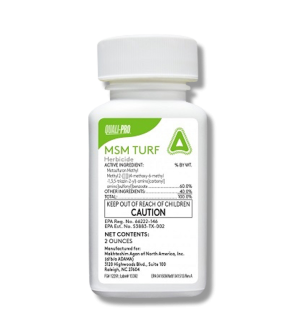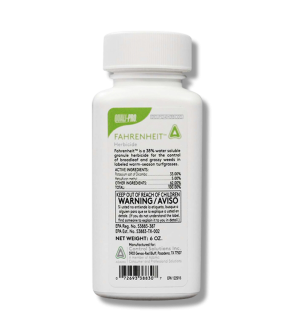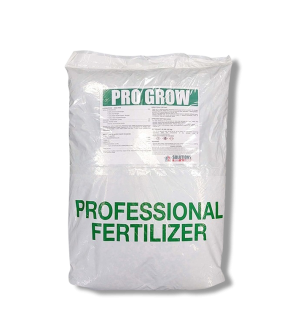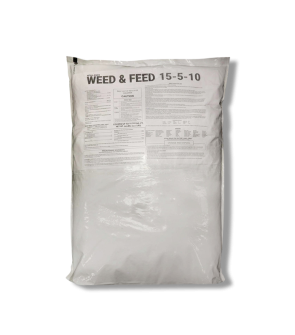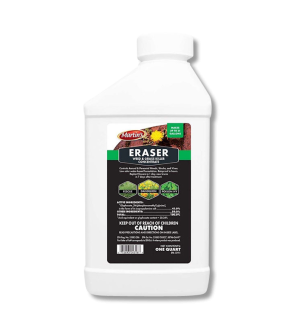Dogfennel Control
Most Effective Products
Dogfennel Control: How to Get Rid of Dogfennel
This page is a general dogfennel control guide. Using the products and methods suggested, you will get control of dogfennel. Follow this DIY guide and use the recommended products, and we guarantee 100% control of dogfennel.
Dogfennel is a tall summer annual or short-lived perennial weed that falls under the name Eupatorium capillifolium or dog fennel and thrives in poorly maintained south eastern to west yards, pastures, and gardens. Depending on the conditions of the turf this weed can grow to reach heights above 3 feet or reach full maturity as a short plant less than 6 inches. Despite the soft touch of the dogfennel leaves this plant secrets a sour and musty odor when crushed.
This broadleaf weed prefers thin terrain containing moist to wet areas, but does not do well in thick, established lawns. Once dogfennel has settled on your property it releases numerous seeds which will quickly suffocate other desired plants. This plant also contains a spreading rootstock that helps dogfennel to survive drought sites, such as Texas terrain.
The name dogfennel comes from this weeds use around the floor of dog kennels to ward off fleas and ticks. This worked, because dogfennel contains an alkaloid toxin, pyrrolizidime that is used in various insecticide products. If dogfennel is crushed then it produces a liquid secretion with the toxic alkaloid, which could cause liver damage. The liver will clog and begin to retain fluids if consumed in large quantities that may cause death.
In this DIY guide, you will learn how to remove and prevent dogfennel on your property by following the steps and recommended products in this article. The directions and products suggested in this DIY guide were composed by our lawn care experts and will show you how to properly remove dogfennel in a quick and cost-efficient manner.
Identification
Before carrying out a treatment program, you will need determine if the weed on your property is dogfennel. Careless identification can lead you to using the wrong treatment method, which can be waste of time and money. Listed below is the identifying characteristics to know what dogfennel looks like:

- Dogfennel can either be tall or short based on the space and nutrients available in its environment. Some reach heights of 6 or more feet tall while others will grow no more than 6 inches in height. Either size will be upright.
- Stems of young dogfennel will soft and easily broken, but as the weed matures it can become woody and tougher.
- Coloration of stems start off as green then to red as the fall season approaches.
- Leaves are thin, hairless, and have a feathery appearance. They are colored a bright yellowish green and change to a subtle silver or red the closer fall approaches.
- Dogfennel is often confused with horseweed, mayweed, and pineapple weed. However, horseweed leaves are more divided and wider than dogfennel leaves. During the seedling stage of growth, dogfennel is mistaken for mayweed or pineapple weed. Unfortunately, the only wall to tell the difference is to crush the plant. When crushed, pineapple weed will have a pleasant aroma of pineapple whereas mayweed or dogfennel odor is unpleasant. Seedling dogfennel also have hairy stems unlike mayweed or pineapple weed.
- Flower blooms from September to November, when present they are small and range in color from white to pale green.
Use the description and image above to help you properly identify dogfennel on your property. If unsure, then contact us with a photo of your weed and we will identify it and suggest treatment options for you.
Inspection
Once you have confirmed that you are dealing with dogfennel, you can then move on to inspection. During this phase, you will locate areas where dogfennel is thriving and observe the conditions that are allowing it to thrive. This information will help you in knowing where to focus your herbicide application.

Where to Inspect
Dogfennel is often seen in pastures, areas of thin turf, parts of your yard prone to flooding or consistent moisture, and yards under poor maintenance. Common sites include, but not limited to, home lawns, pastures, roadsides, and waste areas.
Typically, dogfennel is dormant from January to March, but its seeds will sprout when temperatures reach 65 degrees Fahrenheit. As a summer annual weed, dogfennel can be found in parts of your yard exposed to full sunlight or partial shade.
What to Look For
When found on your property, dogfennel can easily be spotted due to its height or lacy fernlike leaves. This weed typically overcrowds other foliage in the area.
Treatment
Before carrying out a treatment plan, you will need to make sure you have the appropriate personal protective equipment (PPE) prior to handling any herbicide products or entering grassy areas.
Unlike other types of weeds, there is no specific time frame to apply herbicide products. To treat dogfennel, you will need to apply herbicide products containing either 2,4-D, glyphosate, bromoxynilor, clopyralid, dichlobenil, florasulam, fluroxypyr, metribuzin, sulfentrazone, triclopyr, or dicamba when the weed is 20 inches or smaller.
We recommend using Eraser 41% Glyphosphate as this product will treat a large variety of emerged broadleaf weeds like dogfennel on lawns, landscapes, and other terrains. Keep in mind this product is non-selective and will kill any vegetation it comes into contact with so for this reason you will need to do a spot application.
Applications during drought should be avoided, because dogfennel will become tougher in an effort to preserve water. Thus, herbicide material is not able to move completely throughout the dogfennel's stem and roots causing the weed to not receive the full effects of the product being used.
Step 1: Measure Lawn and Mix Herbicide

Begin by calculating the square footage of the treatment area to determine how much product to use. To find this, you will need to measure the length and width of the treatment site in feet and then multiply them together (length X width = square footage). The formula for acreage is to take the square footage and divide it by one acre 43,560 (square footage / 43,560 = acre).
Apply 2 1/2 oz. of Eraser 41% Glyphosate per gallon of water to treat an area as large as 300 sq. ft. You will need to use a handheld pump sprayer during mixing and application.
To mix, pour half of the required amount of water, then fill with measured amount of herbicide, and add the remaining half of water. Close the lid to the sprayer tank and shake to ensure an even mixture.
Step 2: Apply Herbicide in Mid-January to Mid-March
 Adjust the nozzle on your sprayer to a fine spray pattern setting so it will spray a low pressure mist on the dogfennel.
Adjust the nozzle on your sprayer to a fine spray pattern setting so it will spray a low pressure mist on the dogfennel.
Spray the top and bottom of dogfennel leaves until wet, but not to the point of run-off. To better protect desired foliage, we suggest placing a cardboard box around the weed during application.
A suggested time to spray dogfennel is from mid-January to mid-March as this when dogfennel seedlings are beginning to emerge or germinate and when older or more established weeds are sometimes awakening from dormancy.
Check the weather forecast to ensure that no rain or high volume winds are predicted for 24 hours following application to avoid product drift or washed off the treated dogfennel.
Dogfennel with heights of 20 inches or more may need a following application in June as they may take longer to awake from dormancy and harder to control. When less then 20 inches in height, dogfennel is much easier to eliminate and will take less application.
When applied properly, affected weeds will yellow and begin to die. A follow-up application may be necessary if signs of recovery are observed, especially if the plant’s taproot is still alive. A reapplication with Eraser 41% Glyphosate may be made after 4 weeks.
Prevention
After you have treated the dogfennel on your property, you will need to implement some preventative measures to ensure this weed does not return. Implement the following preventative measures to keep the invasive weed from reestablishing.

- Hand-pull seedings with a gloved hand in areas where mowing can not be performed such as garden beds.
- Dogfennel does not do well in thick, established turf so practices such as fertilization are recommended. We recommend Solutions 15-5-10 Weed and Feed Fertilizer with Trimec which acts as a fertilizer and eliminates germinating weeds like dogfennel in turf. Use 3.2 to 4.0 lbs. of product per 1,000 sq. ft.). You will need an inch of water to activate the granules after application.
- Help to further strengthen your grass by mowing at the proper height of 3 to 4 inches in turfgrass. This will help to stimulate growth which will cause grass roots to choke out dogfennel seedlings before they can emerge.
- Improve air circulation in your soil by raking or dethatching your lawn. Circulation in your soil helps nutrients, water, and grass roots spread more easily.
- Once a week, water your lawn deeply with an inch of irrigation in the early mornings. Apply the water all at once in the morning so it has time to seep into the ground without evaporating in the sun.
Key Takeaways
What is Dogfennel?
- Dogfennel is a perennial summer weed that falls under the Asteraceae family with the ability to grow tall or short in thin distressed lawns, pastures, gardens, and grassy areas.
How to Get Rid of Dogfennel
- Our recommendation to remove dogfennel is to use Eraser 41% Glyphosate to completely eliminate this weed.
Preventing Dogfennel
- By maintaining a regular lawn care schedule and promoting a lush, green nutrient rich turf, dogfennel will not be able to establish.

